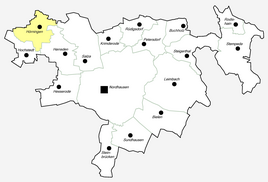Hörningen
|
Hörningen
City of Nordhausen
Coordinates: 51 ° 32 ′ 21 ″ N , 10 ° 42 ′ 50 ″ E
|
|
|---|---|
| Height : | 281 m above sea level NN |
| Residents : | 300 |
| Incorporation : | July 1, 1994 |
| Postal code : | 99734 |
| Area code : | 03631 |
|
Location of Hörningen in Nordhausen
|
|
|
Church in Hörningen
|
|
Hörningen is a district of the city of Nordhausen in Thuringia with around 300 inhabitants.
geography
Hörningen is about eight kilometers northwest of Nordhausen in the southern foreland of the Harz Mountains . Immediately north of the village is the gypsum karst nature reserve Sattelköpfe (Hörninger Kuppen) . The great lake hole , a natural monument in the immediate south-west, is a karst phenomenon with a depth of 17 m and was important as a place of worship in early history .
history
The village of Hörningen was first mentioned in a document in 1238. The area around Hörningen, however, was already settled in prehistoric times. On the mountain spur Birkenkopf , an eastern branch of the Kohnstein , there are walls lying one behind the other. All three ramparts probably protected a hill fort from the Late Bronze and Iron Ages .
In 1945 the place took in a particularly large number of displaced persons . The farmers were subjected to forced collectivization with the formation of two LPGs in the 1950s . During the GDR era, Hörningen was in the 5-kilometer exclusion zone on the inner-German border .
A large " wind park " dominating the landscape was built in the immediate vicinity of the village .
church
Natural monuments
- Saxon oak with a chest height circumference of 6.15 m (2016).
Personalities
- Claudia Bechstein (* 1978), photo model and presenter
Web links
Individual evidence
- ↑ Michael Köhler: Pagan sanctuaries. Jenzig-Verlag, 2007, ISBN 978-3-910141-85-8 , p. 76.
- ^ Wolfgang Kahl : First mention of Thuringian towns and villages. Rockstuhl Verlag, Bad Langensalza, 2010, ISBN 978-3-86777-202-0 , p. 128.
- ↑ Michael Köhler: Thuringian castles and fortified prehistoric and early historical living spaces. Jenzig-Verlag, 2001, ISBN 3-910141-43-9 , p. 67.
- ^ Entry in the directory of monumental oaks . Retrieved January 10, 2017



